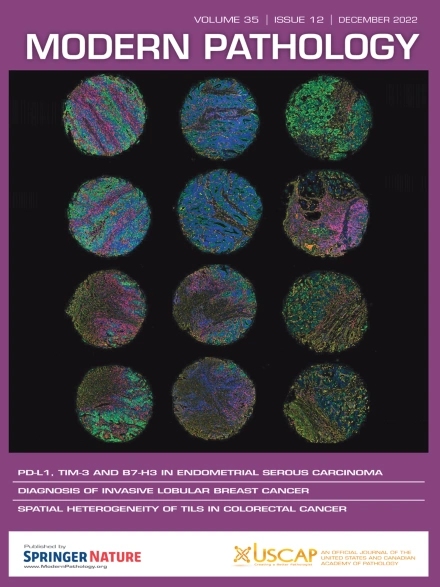先天性支气管周围肌纤维母细胞瘤含有复发性表皮生长因子受体激酶结构域重复。
IF 7.1
1区 医学
Q1 PATHOLOGY
引用次数: 0
摘要
先天性支气管周围肌纤维母细胞瘤(CPMT)是一种罕见的良性婴幼儿肺肿瘤,在产前或婴儿早期出现,组织学特征明显,表现为软骨岛状细胞与平滑纺锤形细胞混杂,有明显的有丝分裂。尽管 CPMT 是良性的,但它可能导致胎儿死亡、产后呼吸窘迫或围产期手术切除并发症。尽管 CPMT 的形态学和临床特征已得到很好的描述,但其分子特征和肿瘤发生机制仍然难以捉摸。在一个索引病例中检测到表皮生长因子受体激酶域18-25外显子重复(KDD)后,我们从档案中又发现了三例形态典型、临床特征良好的CPMT病例,并通过新一代测序技术对所有病例进行了基于RNA和DNA的靶向分析,以检测重排、序列变异和拷贝数变异。其中两例是在产前发现的,一名患者在出生时发病,一名患者在出生后8周发病。所有肿瘤均已切除,随访时间从 0 天到 10 年不等。一名患者在手术切除后不久死亡,另外三名患者没有复发。所有病例均检测到表皮生长因子受体 KDD。在四个病例中,有两个病例出现了选择性全染色体增殖。我们的研究结果确定表皮生长因子受体 KDD 是 CPMT 的复发性致癌驱动因素。值得注意的是,这种改变也出现在经典的先天性间叶细胞性肾瘤(CMNs)中,CPMTs与婴儿肾肿瘤在形态学和临床上有惊人的相似之处。这有力地说明 CPMTs 和典型的 CMNs 有着共同的致癌机制,是不同部位的同一肿瘤。在新生儿软组织肿瘤中也发现了表皮生长因子受体 KDDs,它们具有婴儿纤维肉瘤样组织学和软骨样分化,这引起了人们对它们之间关系的质疑。表皮生长因子受体 KDD 是一种诊断标志物、潜在的治疗靶点,也是了解婴儿间充质肿瘤独特亚群肿瘤发生的窗口。本文章由计算机程序翻译,如有差异,请以英文原文为准。
Congenital Peribronchial Myofibroblastic Tumors Harbor a Recurrent EGFR Kinase Domain Duplication
Congenital peribronchial myofibroblastic tumor (CPMT) is a rare benign infantile pulmonary neoplasm that presents prenatally, or early in infancy, and exhibits distinctive histologic features characterized by the presence of cartilaginous islands intermixed with bland spindle cells, not uncommonly displaying prominent mitoses. Despite its benign nature, CPMT can lead to fetal demise, postnatal respiratory distress, or complications from perinatal surgical resection. Although the morphologic and clinical features of CPMT are well described, its molecular features and oncogenesis remain elusive. Following the detection of EGFR kinase domain duplication (KDD) of exons 18 to 25 in an index case, we identified 3 additional cases of morphologically classic and clinically well-characterized CPMTs from the archives and performed targeted RNA- and DNA-based profiling via next-generation sequencing for detection of rearrangements, sequence variants, and copy number variants on all cases. Two cases were detected prenatally, 1 patient presented at birth, and 1 at 8 weeks of life. All tumors were resected, with a follow-up period ranging from 0 days to 10 years. One patient died shortly after surgical resection, and the other 3 had no recurrences. In all cases, EGFR KDD was detected. In 2 out of 4 cases, gains of select whole chromosomes were noted. Our findings establish EGFR KDD as a recurrent oncogenic driver of CPMT. Notably, this alteration is also found in classical congenital mesoblastic nephromas, infantile kidney tumors with which CPMTs share striking morphologic and clinical similarities. This strongly suggests that CPMTs and classical congenital mesoblastic nephromas share common oncogenesis, and represent the same tumor in different locations. EGFR KDDs have also been reported in neonatal soft tissue tumors with infantile fibrosarcoma-like histology and cartilaginous differentiation, raising questions about their relationship. EGFR KDD emerges as a diagnostic marker, a potential therapeutic target, and a window into the oncogenesis of a distinct subset of infantile mesenchymal tumors.
求助全文
通过发布文献求助,成功后即可免费获取论文全文。
去求助
来源期刊

Modern Pathology
医学-病理学
CiteScore
14.30
自引率
2.70%
发文量
174
审稿时长
18 days
期刊介绍:
Modern Pathology, an international journal under the ownership of The United States & Canadian Academy of Pathology (USCAP), serves as an authoritative platform for publishing top-tier clinical and translational research studies in pathology.
Original manuscripts are the primary focus of Modern Pathology, complemented by impactful editorials, reviews, and practice guidelines covering all facets of precision diagnostics in human pathology. The journal's scope includes advancements in molecular diagnostics and genomic classifications of diseases, breakthroughs in immune-oncology, computational science, applied bioinformatics, and digital pathology.
 求助内容:
求助内容: 应助结果提醒方式:
应助结果提醒方式:


